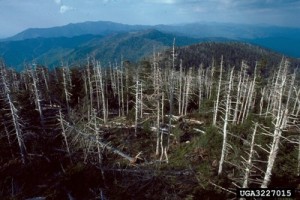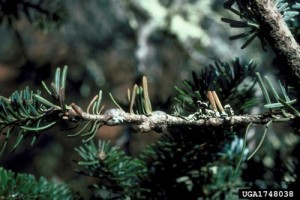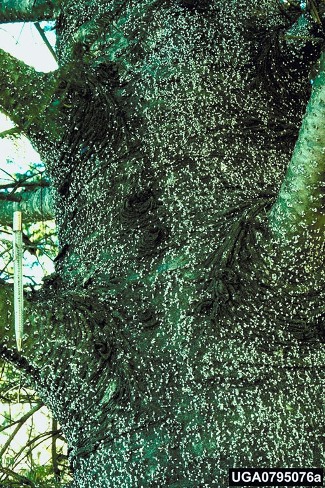Written by: D. Moorhead and G.K. Douce for Forest Encyclopedia Network

The balsam woolly adelgid (Adelges piceae), a native of Europe, was first located in the southern Appalachians in 1957 on Mount Mitchell, North Carolina (Figure 1). It has become a major pest of Fraser fir (Abies fraserii) in the southern Appalachians. Fraser fir is an endemic southern Appalachian tree and the only fir native to the southeastern United States. Fraser fir occurs in the high elevation spruce-fir ecosystem, which is rare in the southern Appalachians (SAMAB 1996). The balsam woolly adelgid has spread throughout the entire range of Fraser fir and now threatens the existence of this rare tree and its unique ecosystem. In addition, Fraser fir is an important species for Christmas tree producers. Balsam woolly adelgid infestations can severely impact Christmas tree plantations via tree damage and the cost of control efforts ( U.S. Forest Service 1989). The balsam woolly adelgid has also become a pest on native true firs throughout Idaho, Washington, and Oregon.

The balsam woolly adelgid is a small (< 1 mm in length), wingless insect. Adults are black to purplish and slightly round. They are not easily visible to the naked eye. However, a noticeable white woolly mass covers the adults and their eggs, making infestations easily visible. These woolly masses appear as white dots along the trunk, limbs, and buds of infested trees (U.S. Forest Service 1989). Within the United States, the entire population is female, and reproduction occurs via unfertilized eggs. Adults lay up to 100 eggs, and two to four generations are produced each year. The mobile immature stage, called crawlers, is orange, with small legs and black eyes (Figure 2). The eggs and crawlers are dispersed mainly by wind but also can be dispersed by birds, mammals, and humans.

When feeding, the adelgids inject salivary compounds into the boles of Fraser firs, stimulating the growth of abnormal xylem cells. These cells, called Roholz cells, are red and wider than normal (SAMAB 1996). The Roholz cells interfere with the ability of the tree to transfer water, causing increased stress. Most species of fir produce a defense response to adeligid infestation, thus reducing the stress. However, Fraser firs usually do not display this response. Initial signs of damage from infestations include gouting (swelling) of twigs and buds and twig dieback ( U.S. Forest Service 1989). A heavily infested tree may die within two to seven years after infestation.

Chemical control of balsam woolly adelgid is very expensive and time consuming. Ornamental trees or Christmas tree plantations can be treated with chemical controls to lessen the impact, but this is not usually feasible in forested settings ( U.S. Forest Service 1989). Other control efforts have been initiated with little result. Currently, Fraser fir populations remain at great risk from balsam woolly adelgid infestations.
Adapted for eXtension.org by Thomas DeGomez, University of Arizona
References Cited
SAMAB (Southern Appalachian Man and the Biosphere). 1996. The southern Appalachian assessment terrestrial technical report. Atlanta: U.S. Department of Agriculture, Forest Service, Southern Region.
USDA – Forest Service, Forest Health Protection. 1989. Insects and Diseases of Trees in the South. USDA – Forest Service. R8-PR16. 98 pp.
Related to Balsam Woolly Adelgid:
- Insects in Forests
- Invasive Forest Insects
- Climate Change Impacts on Forest Insects
- Invasive Species and Climate
- Invasive Species and Biodiversity
